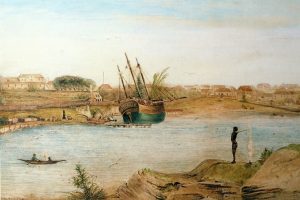
Spectator Magazine – Australia was not invaded
ED: This article was sent to me by Bob Buick MM with the following comment: “I am a subscriber to the Spectator which has many articles of interest, and this piece is an argument against the woke lefty socialists, those many tertiary educated buffoons who accept the Invasion misinformation as historical fact”. I agree with Bob.
https://www.spectator.com.au/2025/01/australia-was-not-invaded/
Australia was not invaded

Sydney Cove, 1808′ by John William Lewin Australia, European. (Photo by Werner Forman/Universal Images Group/Getty Images)
18 January 2025
11:58 PM
Was Australia invaded by Britain on January 26, 1788? For a growing number of people, our national holiday, which marks the arrival of the First Fleet at Sydney Cove, represents an ‘invasion’. According to recent polling, 69 per cent of Australians want to keep Australia Day on January 26, yet anger towards the national holiday has intensified to the point some activists are congratulating those who decapitated a Captain Cook statue. This year, over 150 councils will not be holding citizenship ceremonies on Australia Day. In fact, there is a growing movement to abolish the national holiday altogether because ‘there is nothing to celebrate’. Was Australia really ‘invaded’ as some experts suggest? In short, no. Here’s why.
The goal of the First Fleet was to occupy a small colony, not invade a continent.
The central claim behind the ‘invasion’ argument is that British occupation was not a ‘settlement’. The question is then, did Britain plan an invasion or intentionally seek to occupy the whole country in 1788? For the answer to be ‘yes’, proponents of ‘Invasion Day’ have to read Australian history backwards.
The historian Geoffrey Blainey explains in his book The Tyranny of Distance, ‘Australia held commercial, logistical, and diplomatic importance for the British who were competing with the French and in need of the Flax timber along the eastern coast.’ In fact, the first legal officer of NSW, David Collins, wrote in 1788 that the goal of the First Fleet was not to invade the country but to occupy small areas of land:
‘By the definition of our boundaries it will be seen that we were confined along the coast of this continent to such parts of it as were navigated by Captain Cook, without infringing on … the right of discovery [and] of that right … Great Britain alone has followed up the discoveries she has made in this country by at once establishing in it a regular colony and civil government.’
The historian Bain Attwood in his ground-breaking book Empire and the Making of Native Title helpfully explains that Governor Arthur Phillip’s administration never perceived a need to negotiate this land because the colony ‘merely comprised a small garrison settlement and so had little need for land beyond the beachhead it occupied’. The intention was not to invade, but to form strategic outposts and source flaxwood in a race with the French. That is why the second settlement after Sydney Cove, was not on land nearby. Instead, Phillip travelled to Norfolk Island off the coast of Brisbane, a place not known to Aboriginal people. As Geoffrey Blainey explains in The Australian, ‘Its inhabitants [on Norfolk Island] certainly have no reason to talk of Invasion Day.’
So why did Britain come to the southern continent? According to Blainey, the justification for settling Australia were many:
‘Contrary to popular belief, Britain did not find or settle Australia because of overcrowded gaols. There were other ports in South Africa and across the Empire that would have been much cheaper overseas prisons. Likewise, many other European countries simply built more prisons. These options were available to the British.’
It is therefore historically inaccurate to describe January 26, 1788, as an ‘invasion’ when its original intention was to occupy a small colony restricted to the coast of Australia.
Aboriginal people did not see British colonisation as an ‘invasion’.
What was the original reaction to the so-called ‘invasion’ of the British from the perspective of Aboriginal people? The answer is more complicated than most people think. Anthropologist Peter Sutton in an academic paper titled, Stories about feeling: Dutch–Australian contact in Cape York Peninsula, 1606–1756 documents the very mixed reactions of Aboriginal people to European contact. Sutton writes:
First encounters with Europeans were arguably experienced by Aboriginal people in anything but territorial terms. They were most often, it seems, primarily an encounter with relatives who had gone to the spirit world and returned…
What about the First Fleet? Historian Bain Attwood argues:
In the beginning, Phillip’s party found it difficult to forge a relationship with the Aboriginal people. Indeed, several months after the British had landed, Phillip reported that the local people repeatedly avoided them. In due course, a good deal of cross-cultural exchange did in fact occur…
From early Dutch encounters to the January 26, European encounters with the British were mostly characterised by indifference. Labelling Australia Day an ‘invasion’ ignores the fact Aboriginal people never viewed early European encounters as territorial usurpation.
Aboriginal people did not have a European concept of land ownership.
Since 2006, activists have begun referring to Australia Day as ‘Sovereignty Day’. The ‘core of the issue is the concept of Sovereignty’ writes the SBS, ‘which means the inherent jurisdiction of Indigenous Australians over their lands … that existed before European arrival and was never ceded.’ Is this true?
An invasion requires the acquisition of land. If that land is not owned, it is essentially impossible to ‘invade’ in the conventional sense of the word. Peter Sutton again points out in his article on early European contact:
‘For most Aboriginal people of a classical cast of thought there was no publicly ordained conception of territory as something that could be annexed, by force or without force. It was a sacred endowment and not a secular achievement.’
Did Europeans realise that Aboriginal people were the occupants living there? ‘There can be no doubt,’ writes Attwood, ‘that some colonists believed that Aboriginal people had been the original possessors of the land and that consequently they had a moral duty to ensure that the natives were recompensed.’ However, in my view it would be more accurate to say that according to Aboriginal peoples the Land owned them (See A.P. Elkin, Aboriginal Men of High Degree). From an Aboriginal point of view, it is therefore not possible to ‘invade’ the Land in a fully European sense, because no one owned it.
Could it be argued that Aboriginal people exemplified a natural connection to the land that Europeans should have been immediately recognised? As Geoffrey Blainey explains in his book Triumph of the Nomads, many Aboriginal people did not stay in the same place for long periods of time, ‘While many aboriginals spent every month of their life in their traditional territory, others might spend most of their life in alien territory.’ This does not undermine any violent interactions between the British and Aboriginal people after 1788, but it does show January 26 was not, by any stretch of the definition, an invasion.
Many Aboriginal people were never dispossessed.
Some have claimed that the ‘British were armed to the teeth’ and engaged in the murdering and dispossession of the Aboriginal people nearly as soon as they arrived. The assumption behind the argument for an ‘invasion day’ relies on the claim Aboriginal people were systematically ‘slaughtered and dispossessed’. The truth is more complicated.
Academic research done by one of Australia’s most renowned academics, William Stanner, shows in his book White Man Got No Dreaming, that many Aboriginal people chose to migrate to colonised areas for work and opportunity.
‘… for every Aboriginal who, so to speak, had Europeans thrust upon him, at least one other had sought them out. More would have gone to European centres sooner had it not been that their way was often barred by hostile Aborigines. As late as the early 1930s I was able to see for myself the battles between the encroaching myalls and weakening, now-sedentary groups who had monopolised European sources of supply and work.’
Stanner never encountered an Aboriginal whoever wanted to return to the bush and their traditional way of life, even in cases of miserable urban circumstances. They simply ‘went because they wanted to, and stayed because they wanted to’.
As Stanner points out, not enough work has been done to properly account for the numbers and scale of this migration due to a historical silence on the matter. Instead, scholars are ‘prone’, to reductionistic models of explanation which place all the weight on ‘dramatic secondary causes’ such as ‘violence, disease, neglect, prejudice, or on the structure of Aboriginal society, or both’.
It is therefore misleading to call all of British settlement an ‘invasion’ considering a large amount of Aboriginal people willingly migrated and chose to live with the so-called ‘invaders’. Not to mention that over 50 per cent of Australia’s land is under Aboriginal ownership through Native Title claims. Undeniably, many Aboriginal Australians today are not ‘dispossessed’, considering most remote communities have a Native Title agreement.
The coming of the British was less violent than Aboriginal tribal warfare.
It has been famously argued that Australia Day celebrates ‘the coming of one race at the expense of another’. Some organisations explain the public holiday ‘marks the beginning of a long and brutal colonisation of people and land’. These statements do not acknowledge the historical context of British colonisation. It assumes that life would have been better and less violent if the British never ‘invaded’. This is not the case.
A key source was a British settler named Edward Stone Parker who was the assistant protector of Aborigines who studied Aboriginal languages and a knowledge of their traditional way of life. He famously remarked, ‘On the whole their way of life was a satisfying one, and could have been almost idyllic – but for their frequent fighting and the persistent fear of revenge.’ Parker goes on to quote a well-informed Aboriginal man who argued before the British arrived ‘the country was strewed with bones, and were always at war’. Indeed ‘whole tribes have been exterminated by sudden attacks on nocturnal surprises’. While Parker strongly denounced the conflict between settlers and Aborigines, he identified that the wars between tribes were more destructive.
The fighting was both brutal and constant. The British settler with the most experience in observing traditional warfare was William Buckley, an escaped convict who lived with a friendly Aboriginal group. After two women in Buckley’s group were killed, an ambush soon followed where several women were wounded and later beaten to death. Their limbs were removed by sharp stone axes and shells.
In The Life and Adventures of William Buckley it says:
Buckley records fourteen conflicts involving the violent death of a tribe member over the thirty-two years that he lived with the Wallarranga. Nine of the causalities were women, seven children and seven men. Ten enemies (two of whom were children) were killed in revenge. Buckley also documents the massacre of a tribe near Barwon Heads…. Buckley cites just two principal causes for the conflict: disputes over women, and ‘payback killings’ following a death by natural causes.
There are even incidents of invasion and groups pushing out traditional holders of territory. For example, The Goonyandi people who occupied an area larger than the African nation of Gambia was dislocated by their neighbouring tribe, the Walmadjari people. This happened across the country in the Western coast to Central Australia, and in the words of Blainey ‘the loss of territory must have been a frequent event’. Blainey, argues in his book The Story of Australia’s People, (which won the Prime Ministers literary award in 2016):
Such comparisons reveal that the annual death rate through warfare in that corner of Arnhem Land was nearly six times as high as that of the United States during an average year of its participation in the Second World War. Even the direct drain on Japan’s population through the loss of fighting men in China, the Pacific and all other theatres of war between 1937 and 1945 was not quite as high, statistically, as warfare’s drain on the population of Arnhem Land. In the Second World War, only the armed forces of the Soviet Union and Germany suffered losses of higher relative magnitude.
Calling Australia Day ‘Invasion Day’, ultimately ignores the harsh reality of life prior to 1788, and paints a one-sided view of history to favour a political movement.
Australia Day is an important holiday commemorating the unified cultural link we all share as descendants of Britain. This includes the rule of law, sport, education, music, art, politics, and the English language to name a few. Changing the date and the name of Australia Day would erode the unity our forebears worked so hard to create, and would legitimise a view of history which is simply not true.




